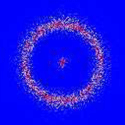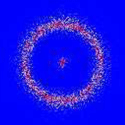Bird feathers inspire mirrorless laser
In a traditional laser, light is temporarily trapped inside a mirrored cavity, where it can be amplified by the gain medium. In the past decade, researchers have developed mirrorless lasers that trap light with internal nanostructures that scatter light in different directions. A new two-dimensional mirrorless laser—described in Physical Review Letters —uses a quasirandom array of small air holes. The design mimics the way light scatters from embedded air pockets found in certain bird feathers.
Previous mirrorless lasers have been made from materials of various levels of structural organization. Random lasers, for example, are made from powders or porous glasses, in which randomly arranged surfaces provide multiple scattering sites. In contrast, photonic crystal lasers have periodic lattices that scatter light in well-defined directions due to interference effects.
For the first time, Heeso Noh of Yale University and his colleagues have produced lasing in a system that is globally random but locally ordered. Their inspiration came from kingfishers and parrots, whose feathers get their color not from pigment molecules but from a largely random distribution of air pockets. These nanostructures scatter light at specific wavelengths that are determined by short-range order in the spacing between the pockets. Using this as a model, the team etched an array of roughly - -wide holes into a semiconductor film that contained quantum dots as a gain medium. When the researchers optically excited the two-dimensional device with sufficient power, it emitted laser light at a frequency that could be tuned by changing the spacing and radius of the air holes. – Michael Schirber





